Ammunition
Finding the right ammo for you and your firearm can greatly increase your accuracy and time Shooting - versus dealing with failures to feed, fire and eject.
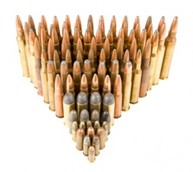
Here's the types of ammunition that we like for Shooting and why we like them:
- .22 Caliber
- 9mm
- 5.56mm
- .223 Caliber
- 7.62 x 39 mm
- .410 Bore
- 12 Gauge
- Note: click on any photo to enlarge it
.22 Caliber Ammo
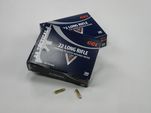
CCI AR Tactical (MFG: 0956 - UPC 076683009562)
For normal purposes we like to shoot ammo that our guns like. For .22s there is a lot of cheap ammo on the market. Some of it is better than others, but in general cheap ammo is normally worse for the gun so we stay away from it. For our .22 caliber firearms we generally use CCI ammo. The criteria that we use to evaluate .22 caliber ammunition are: 1) caliber, 2) bullet material, 3) casing material, 4) quality, 5) expected number of failures, 6) dirtyness and 7) price. This .22 caliber ammunition (0956) has a 40 grain round-nosed copper-FMJ bullet that has a muzzle velocity of 1,200 fps. It comes 300 to a box and normally can be found for approximately 8.3 cents per round. For our S&W 15-22 this is our preferred ammo since it is specifically made for tactical firearms. You can buy this ammo at targetsportsusa.com (although sometimes it is out of stock due to the continuous high demand for .22 caliber ammo) or at your local gun stores.
For normal purposes we like to shoot ammo that our guns like. For .22s there is a lot of cheap ammo on the market. Some of it is better than others, but in general cheap ammo is normally worse for the gun so we stay away from it. For our .22 caliber firearms we generally use CCI ammo. The criteria that we use to evaluate .22 caliber ammunition are: 1) caliber, 2) bullet material, 3) casing material, 4) quality, 5) expected number of failures, 6) dirtyness and 7) price. This .22 caliber ammunition (0956) has a 40 grain round-nosed copper-FMJ bullet that has a muzzle velocity of 1,200 fps. It comes 300 to a box and normally can be found for approximately 8.3 cents per round. For our S&W 15-22 this is our preferred ammo since it is specifically made for tactical firearms. You can buy this ammo at targetsportsusa.com (although sometimes it is out of stock due to the continuous high demand for .22 caliber ammo) or at your local gun stores.
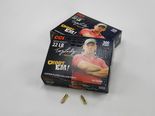
CCI Troy Landry Mini-Mag High Velocity (MFG: 0962 - UPC 076683009623)
Our second favorite .22 caliber ammo is the CCI Troy Landry Mini-Mag High Velocity. The criteria that we use to evaluate .22 caliber ammunition are: 1) caliber, 2) bullet material, 3) casing material, 4) quality, 5) expected number of failures, 6) dirtyness and 7) price. This .22 caliber ammunition (0962) has a 36 grain hollow-point copper-FMJ bullet that has a muzzle velocity of 1,260 fps. It comes 300 to a box and normally can be found for approximately 8.3 cents per round. You can buy this ammo at targetsportsusa.com (although sometimes it is out of stock due to the continuous high demand for .22 caliber ammo) or at your local gun stores.
Our second favorite .22 caliber ammo is the CCI Troy Landry Mini-Mag High Velocity. The criteria that we use to evaluate .22 caliber ammunition are: 1) caliber, 2) bullet material, 3) casing material, 4) quality, 5) expected number of failures, 6) dirtyness and 7) price. This .22 caliber ammunition (0962) has a 36 grain hollow-point copper-FMJ bullet that has a muzzle velocity of 1,260 fps. It comes 300 to a box and normally can be found for approximately 8.3 cents per round. You can buy this ammo at targetsportsusa.com (although sometimes it is out of stock due to the continuous high demand for .22 caliber ammo) or at your local gun stores.
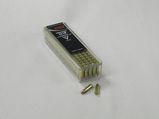
CCI Mini-Mag High Velocity (MFG: 0030 - UPC 076683000309)
The final type of .22 caliber CCI ammo that we shoot is CCI Mini-Mag High Velocity. The criteria that we use to evaluate .22 caliber ammunition are: 1) caliber, 2) bullet material, 3) casing material, 4) quality, 5) expected number of failures, 6) dirtyness and 7) price. This .22 caliber ammunition (0030) has a 40 grain round-nosed copper-FMJ bullet that has a muzzle velocity of 1,235 fps. It comes 100 to a box and normally can be found for approximately 10 cents per round. You can buy this ammo at targetsportsusa.com or your local gun stores.
The final type of .22 caliber CCI ammo that we shoot is CCI Mini-Mag High Velocity. The criteria that we use to evaluate .22 caliber ammunition are: 1) caliber, 2) bullet material, 3) casing material, 4) quality, 5) expected number of failures, 6) dirtyness and 7) price. This .22 caliber ammunition (0030) has a 40 grain round-nosed copper-FMJ bullet that has a muzzle velocity of 1,235 fps. It comes 100 to a box and normally can be found for approximately 10 cents per round. You can buy this ammo at targetsportsusa.com or your local gun stores.
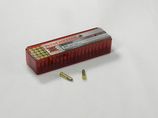
Winchester Super X (MFG: X22LRH - UPC 020892102026)
The only .22 caliber ammo that we shoot that is not made by CCI is what we normally use in our Winchester Model 121; Winchester Super X ammo. The criteria that we use to evaluate .22 caliber ammunition are: 1) caliber, 2) bullet material, 3) casing material, 4) quality, 5) expected number of failures, 6) dirtyness and 7) price. This .22 caliber ammunition (X22LRH) has a 37 grain hollow-point copper-FMJ bullet that has a muzzle velocity of 1,330 fps. It comes 50 to a box and normally can be found for approximately 8 cents per round. You can buy this ammo at targetsportsusa.com or your local gun stores.
The only .22 caliber ammo that we shoot that is not made by CCI is what we normally use in our Winchester Model 121; Winchester Super X ammo. The criteria that we use to evaluate .22 caliber ammunition are: 1) caliber, 2) bullet material, 3) casing material, 4) quality, 5) expected number of failures, 6) dirtyness and 7) price. This .22 caliber ammunition (X22LRH) has a 37 grain hollow-point copper-FMJ bullet that has a muzzle velocity of 1,330 fps. It comes 50 to a box and normally can be found for approximately 8 cents per round. You can buy this ammo at targetsportsusa.com or your local gun stores.
9mm Ammo
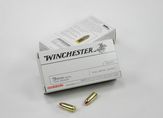
Winchester 9mm NATO (MFG: Q4318 - UPC 020892212213)
Shooting 9mm ammo as much as we do can get expensive. So we searched for a good quality ammo that could be purchased at a reasonable price. The criteria that we use to evaluate 9mm ammunition are: 1) caliber, 2) bullet material, 3) casing material, 4) quality, 5) expected number of failures, 6) dirtyness and 7) price. After buying and shooting lots of different brands and types of 9mm ammo we settled on Winchester 9mm NATO as our standard round. It is reliable, accurate and reasonably priced. This 9mm ammunition (Q4318) has a 124 grain round-nosed copper-FMJ bullet that has a muzzle velocity of 1,140 fps. It comes 50 to a box and normally can be found for approximately 26 cents per round. One word of caution, although this ammo comes in a white box it is not the standard Winchester White Box (WWB) ammo that you see at Walmart and other locations. Although they are both Winchester 9mm ammo the WWB ammo is “Luger” ammo and this is “NATO” ammo. The quality standards are different and the pressure standards for the rounds are noticeably different. The industry uses SAAMI Standards to measure the pressures that ammo is loaded at. The SAAMI pressure for 9mm Luger ammo is approximately 35,000 PSI and 9mm NATO ammo is pressured at 36,500 PSI. So, when compared to the Luger ammo, the 9mm NATO ammo has a higher pressure that is analogous to the 9mm +P load of 36,000 PSI. For us this additional pressure helps our guns cycle better - especially our carbines. Some people think that shooting higher pressure rounds has adverse impacts on your guns, and it probably does increase wear and tear. But, since we use this ammo on firearms that are relatively new, our opinion is that if you’re not shooting hundreds of rounds each month then there isn't too much to be concerned about. You can buy this ammo at targetsportsusa.com or your local gun stores.
Shooting 9mm ammo as much as we do can get expensive. So we searched for a good quality ammo that could be purchased at a reasonable price. The criteria that we use to evaluate 9mm ammunition are: 1) caliber, 2) bullet material, 3) casing material, 4) quality, 5) expected number of failures, 6) dirtyness and 7) price. After buying and shooting lots of different brands and types of 9mm ammo we settled on Winchester 9mm NATO as our standard round. It is reliable, accurate and reasonably priced. This 9mm ammunition (Q4318) has a 124 grain round-nosed copper-FMJ bullet that has a muzzle velocity of 1,140 fps. It comes 50 to a box and normally can be found for approximately 26 cents per round. One word of caution, although this ammo comes in a white box it is not the standard Winchester White Box (WWB) ammo that you see at Walmart and other locations. Although they are both Winchester 9mm ammo the WWB ammo is “Luger” ammo and this is “NATO” ammo. The quality standards are different and the pressure standards for the rounds are noticeably different. The industry uses SAAMI Standards to measure the pressures that ammo is loaded at. The SAAMI pressure for 9mm Luger ammo is approximately 35,000 PSI and 9mm NATO ammo is pressured at 36,500 PSI. So, when compared to the Luger ammo, the 9mm NATO ammo has a higher pressure that is analogous to the 9mm +P load of 36,000 PSI. For us this additional pressure helps our guns cycle better - especially our carbines. Some people think that shooting higher pressure rounds has adverse impacts on your guns, and it probably does increase wear and tear. But, since we use this ammo on firearms that are relatively new, our opinion is that if you’re not shooting hundreds of rounds each month then there isn't too much to be concerned about. You can buy this ammo at targetsportsusa.com or your local gun stores.
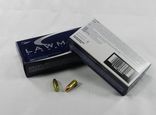
Speer Lawman 9mm Luger 115 Grain Total Metal Jacket (MFG: 53615 - UPC 076683536150) – 124 Grain Total Metal Jacket (MFG: 53651 - UPC 076683536518)
Since our normal 9mm ammo is analogous to a +P round, and this can cause additional wear and tear on some firearms, we looked for another 9mm round to use at the range that would complement the NATO round. The criteria that we use to evaluate 9mm ammunition are: 1) caliber, 2) bullet material, 3) casing material, 4) quality, 5) expected number of failures, 6) dirtyness and 7) price. After testing various types of 9mm ammo we selected Speer Lawman 9mm Luger Total Metal Jacket ammo which comes in both 115 grain and 124 grain variants, The 115 grain 9mm ammunition (53615) has round-nosed copper-TMJ bullet with a muzzle velocity of 1,200 fps. The 124 grain 9mm ammunition (53651) has round-nosed copper-TMJ bullet with a muzzle velocity of 1,090 fps. They both come 50 to a box and normally can be found for approximately 26 cents per round. The difference between TMJ and FMJ is that with TMJ rounds the entire bullet is covered in the copper metal jacket – including the back side of the bullet. FMJ bullets have lead exposed at the base, or have a second piece to cover the lead. These FMJ bases can deform under pressure and reduce accuracy. TMJ rounds also reduce airborne lead so that they won’t foul ported recoil compensators like open-base bullets do. We like this ammo since it is clean, accurate and fast for a 9mm bullet. You can buy this ammo at targetsportsusa.com or your local gun stores.
Since our normal 9mm ammo is analogous to a +P round, and this can cause additional wear and tear on some firearms, we looked for another 9mm round to use at the range that would complement the NATO round. The criteria that we use to evaluate 9mm ammunition are: 1) caliber, 2) bullet material, 3) casing material, 4) quality, 5) expected number of failures, 6) dirtyness and 7) price. After testing various types of 9mm ammo we selected Speer Lawman 9mm Luger Total Metal Jacket ammo which comes in both 115 grain and 124 grain variants, The 115 grain 9mm ammunition (53615) has round-nosed copper-TMJ bullet with a muzzle velocity of 1,200 fps. The 124 grain 9mm ammunition (53651) has round-nosed copper-TMJ bullet with a muzzle velocity of 1,090 fps. They both come 50 to a box and normally can be found for approximately 26 cents per round. The difference between TMJ and FMJ is that with TMJ rounds the entire bullet is covered in the copper metal jacket – including the back side of the bullet. FMJ bullets have lead exposed at the base, or have a second piece to cover the lead. These FMJ bases can deform under pressure and reduce accuracy. TMJ rounds also reduce airborne lead so that they won’t foul ported recoil compensators like open-base bullets do. We like this ammo since it is clean, accurate and fast for a 9mm bullet. You can buy this ammo at targetsportsusa.com or your local gun stores.
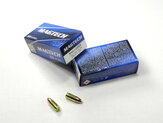
Magtech Sport 9mm Luger 115 Grain Full Metal Jacket (MFG: BZ0214-9A - UPC 754908114016) - 124 Grain Full Metal Jacket (MFG: BT0529-9B - UPC 754908115013)
Since there always seems to be some variability in the availability of ammo, in addition to purchasing ammo ahead of time and storing it, we’ve also found that having a couple brands of ammo that are “tried and true” is a good idea. For us this is especially true of 9mm ammo since we shoot more of it than any other caliber. The criteria that we use to evaluate 9mm ammunition are: 1) caliber, 2) bullet material, 3) casing material, 4) quality, 5) expected number of failures, 6) dirtyness and 7) price. To complement the Winchester NATO and the Speer Lawman 9mm ammo that we normally shoot we tried out several other brands and grain weights. Ultimately we decided to purchase Magtech Sport ammo as our secondary brand for a variety of reasons: 1) Magtech is manufactured in Brazil by Companhia Brasileira de Cartuchos (CBC) - one of the largest manufacturers of ammunition in the world and the owners of Sellier & Bellot (S&B); 2) their "Sport" line of ammo was designed for shooters looking for accuracy, reliability and performance; 3) the ammo comes in both 115 grain and 124 grain variants – matching our 9mm Speer and Winchester grain weights; 4) the ammo is new production, non-corrosive, re-loadable ammo featuring brass cases and boxer primers; and 5) the price point averages between 18 and 24 cents per round ($8.99 to $11.99 per box of 50). The 115 grain (BZ0214-9A) round-nosed copper FMJ bullet has a muzzle velocity of 1,135 fps with 329 foot pounds of energy. The 124 grain (BT0529-9B) round-nosed copper FMJ bullet has a muzzle velocity of 1,109 fps with 339 foot pounds of energy. Since this ammo is specifically designed for the high volume shooter it’s clean, accurate and a great option for either target shooting or plinking. You can buy this ammo at targetsportsusa.com or your local gun stores.
Since there always seems to be some variability in the availability of ammo, in addition to purchasing ammo ahead of time and storing it, we’ve also found that having a couple brands of ammo that are “tried and true” is a good idea. For us this is especially true of 9mm ammo since we shoot more of it than any other caliber. The criteria that we use to evaluate 9mm ammunition are: 1) caliber, 2) bullet material, 3) casing material, 4) quality, 5) expected number of failures, 6) dirtyness and 7) price. To complement the Winchester NATO and the Speer Lawman 9mm ammo that we normally shoot we tried out several other brands and grain weights. Ultimately we decided to purchase Magtech Sport ammo as our secondary brand for a variety of reasons: 1) Magtech is manufactured in Brazil by Companhia Brasileira de Cartuchos (CBC) - one of the largest manufacturers of ammunition in the world and the owners of Sellier & Bellot (S&B); 2) their "Sport" line of ammo was designed for shooters looking for accuracy, reliability and performance; 3) the ammo comes in both 115 grain and 124 grain variants – matching our 9mm Speer and Winchester grain weights; 4) the ammo is new production, non-corrosive, re-loadable ammo featuring brass cases and boxer primers; and 5) the price point averages between 18 and 24 cents per round ($8.99 to $11.99 per box of 50). The 115 grain (BZ0214-9A) round-nosed copper FMJ bullet has a muzzle velocity of 1,135 fps with 329 foot pounds of energy. The 124 grain (BT0529-9B) round-nosed copper FMJ bullet has a muzzle velocity of 1,109 fps with 339 foot pounds of energy. Since this ammo is specifically designed for the high volume shooter it’s clean, accurate and a great option for either target shooting or plinking. You can buy this ammo at targetsportsusa.com or your local gun stores.
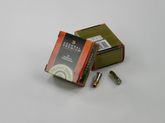
Federal Premium 9mm Luger Hydra-Shok JHP (MFG: P9HS2 - UPC 029465088095)
Although we use Winchester NATO 124 grain and Speer Lawman 115 grain ammo at the range, for our “carry” ammo we wanted a round specifically designed for self-defense. The criteria that we use to evaluate 9mm self-defense ammunition are: 1) caliber, 2) bullet material, 3) casing material, 4) quality, 5) expected number of failures, 6) dirtiness, 7) bullet impact, 8) bullet expansion and 9) price. Based on our research and shooting trials we decided to use Federal Premium 9mm Luger Hydra-Shok JHP ammo for our Beretta 92FS. This 9mm ammunition (P9HS2) has a 147 grain hollow-point copper-FMJ bullet that has a muzzle velocity of 1,000 fps. It comes 20 to a box and normally can be found for approximately $1.15 per round. You can buy this ammo at Cabela’s or your local gun stores.
Although we use Winchester NATO 124 grain and Speer Lawman 115 grain ammo at the range, for our “carry” ammo we wanted a round specifically designed for self-defense. The criteria that we use to evaluate 9mm self-defense ammunition are: 1) caliber, 2) bullet material, 3) casing material, 4) quality, 5) expected number of failures, 6) dirtiness, 7) bullet impact, 8) bullet expansion and 9) price. Based on our research and shooting trials we decided to use Federal Premium 9mm Luger Hydra-Shok JHP ammo for our Beretta 92FS. This 9mm ammunition (P9HS2) has a 147 grain hollow-point copper-FMJ bullet that has a muzzle velocity of 1,000 fps. It comes 20 to a box and normally can be found for approximately $1.15 per round. You can buy this ammo at Cabela’s or your local gun stores.
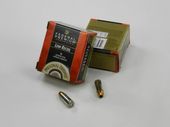
Federal Premium 9mm Luger Hydra-Shok JHP - Low Recoil (MFG: PD9HS5H - UPC 029465091484)
Since our S&W Shield is a smaller handgun than our Beretta 92FS, we looked for a round that had lower recoil for our "carry" ammo. The criteria that we use to evaluate 9mm ammunition are: 1) caliber, 2) bullet material, 3) casing material, 4) quality, 5) expected number of failures, 6) dirtiness, 7) bullet impact, 8) bullet expansion, 9) recoil and 10) price. As luck would have it Federal makes a 9mm Luger Hydra-Shok JHP round that is low recoil - so we use it with our Shield’s 7 round magazines. This 9mm ammunition (PD9HS5H) has a 135 grain hollow-point copper-FMJ bullet that has a muzzle velocity of 1,060 fps. It comes 20 to a box and normally can be found for approximately $1.10 per round. You can buy this ammo at Cabela’s or your local gun stores..
Since our S&W Shield is a smaller handgun than our Beretta 92FS, we looked for a round that had lower recoil for our "carry" ammo. The criteria that we use to evaluate 9mm ammunition are: 1) caliber, 2) bullet material, 3) casing material, 4) quality, 5) expected number of failures, 6) dirtiness, 7) bullet impact, 8) bullet expansion, 9) recoil and 10) price. As luck would have it Federal makes a 9mm Luger Hydra-Shok JHP round that is low recoil - so we use it with our Shield’s 7 round magazines. This 9mm ammunition (PD9HS5H) has a 135 grain hollow-point copper-FMJ bullet that has a muzzle velocity of 1,060 fps. It comes 20 to a box and normally can be found for approximately $1.10 per round. You can buy this ammo at Cabela’s or your local gun stores..
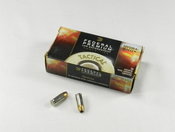
Federal Premium 9mm Luger Hydra-Shok JHP - Tactical Law Enforcement Ammunition (MFG: P9HS1G1 - UPC 029465091477)
Since the 9mm ammo that we shoot the most at the range in our S&W Shield is Winchester NATO 124 grain ammo, we looked around to see if there was a compatible 124 grain “carry” ammo. The criteria that we use to evaluate 9mm ammunition are: 1) caliber, 2) bullet material, 3) casing material, 4) quality, 5) expected number of failures, 6) dirtiness, 7) bullet impact, 8) bullet expansion, 9) recoil and 10) price. Once again Federal was there with a solution; 9mm Federal Premium Hydra-Shok 124 gr JHP Tactical Law Enforcement Ammunition. This 9mm ammunition (P9HS1G1) has a 124 grain hollow-point copper-FMJ bullet with a muzzle velocity of 1,120 fps. These rounds were specially designed for and by Navy SEAL teams and feature a hollow point design with a tapered center post that directs the impact forces against the inner walls of the bullet cavity resulting in a more reliable and consistent mushroom. It comes 50 to a box and normally can be found for approximately $0.48 per round. You can buy this ammo at targetsportsusa.com or your local gun stores.
Since the 9mm ammo that we shoot the most at the range in our S&W Shield is Winchester NATO 124 grain ammo, we looked around to see if there was a compatible 124 grain “carry” ammo. The criteria that we use to evaluate 9mm ammunition are: 1) caliber, 2) bullet material, 3) casing material, 4) quality, 5) expected number of failures, 6) dirtiness, 7) bullet impact, 8) bullet expansion, 9) recoil and 10) price. Once again Federal was there with a solution; 9mm Federal Premium Hydra-Shok 124 gr JHP Tactical Law Enforcement Ammunition. This 9mm ammunition (P9HS1G1) has a 124 grain hollow-point copper-FMJ bullet with a muzzle velocity of 1,120 fps. These rounds were specially designed for and by Navy SEAL teams and feature a hollow point design with a tapered center post that directs the impact forces against the inner walls of the bullet cavity resulting in a more reliable and consistent mushroom. It comes 50 to a box and normally can be found for approximately $0.48 per round. You can buy this ammo at targetsportsusa.com or your local gun stores.
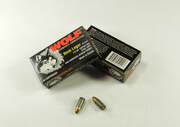
Wolf Performance 9mm 115 Grain FMJ Steel Case Ammo (MFG: P919FMJ – UPC 645611919213)
Like with our AK-variant rifle (a MAK-90), with our AK carbine (Kalashnikov KR-9S) we wanted to keep the "low cost/rugged" experience as real as possible by using steel case ammo in the firearm; even though there is a wide range of opinions related to using steel vs. brass case ammo. The criteria that we use to evaluate 9mm ammunition are: 1) caliber, 2) bullet material, 3) casing material, 4) quality, 5) expected number of failures, 6) dirtyness and 7) price. Since we had previously performed a detailed comparison of Wolf, Bear and Tula steel ammo when we selected 7.62 x 39mm ammunition for our MAK-90, this time we only looked at Wolf 9mm ammo and selected Wolf Performance 9mm 115 Grain FMJ Steel Case ammo for our KR-9S. This ammo (P919FMJ) has a round-nosed bimetal jacketed FMJ bullet (designed by compressing alternating sheets of copper and steel), a polymer coated steel casing to ensure smooth feeding and extraction and uses non-corrosive Berdan primers. It is a standard pressure load with a muzzle velocity of 1,150 fps. It comes 50 to a box and normally can be found for approximately 16 cents per round. You can buy this ammo at targetsportsusa.com or your local gun stores.
Like with our AK-variant rifle (a MAK-90), with our AK carbine (Kalashnikov KR-9S) we wanted to keep the "low cost/rugged" experience as real as possible by using steel case ammo in the firearm; even though there is a wide range of opinions related to using steel vs. brass case ammo. The criteria that we use to evaluate 9mm ammunition are: 1) caliber, 2) bullet material, 3) casing material, 4) quality, 5) expected number of failures, 6) dirtyness and 7) price. Since we had previously performed a detailed comparison of Wolf, Bear and Tula steel ammo when we selected 7.62 x 39mm ammunition for our MAK-90, this time we only looked at Wolf 9mm ammo and selected Wolf Performance 9mm 115 Grain FMJ Steel Case ammo for our KR-9S. This ammo (P919FMJ) has a round-nosed bimetal jacketed FMJ bullet (designed by compressing alternating sheets of copper and steel), a polymer coated steel casing to ensure smooth feeding and extraction and uses non-corrosive Berdan primers. It is a standard pressure load with a muzzle velocity of 1,150 fps. It comes 50 to a box and normally can be found for approximately 16 cents per round. You can buy this ammo at targetsportsusa.com or your local gun stores.
5.56mm Ammo
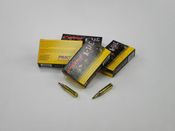
PMC 5.56mm NATO X-TAC M855 LAP (MFG: 5.56K - UPC 741569010122)
Once you step up to 5.56mm ammo you can really spend serious money at the range. Since we are shooting for fun, and not for competition, we looked for a round that was good for target shooting but was still reasonably priced. The other complication that we had was that since our Stag Model 3 has a 1/7 twist we really need to shoot 62 grain rounds instead of the standard 55 grain rounds. The criteria that we use to evaluate 5.56mm ammunition are: 1) caliber, 2) bullet weight, 3) bullet material, 4) casing material, 5) quality, 6) expected number of failures, 7) dirtyness and 8) price. This 5.56mm ammunition (5.56K) has a 62 grain green tipped LAP copper jacketed steel bullet that has a muzzle velocity of 3,100 fps. It comes 20 to a box and normally can be found for approximately 40 cents per round. You can buy this ammo at targetsportsusa.com or your local gun stores.
If you're interested in the differences between 5.56mm and .223 caliber ammo here's a great 12:20 minute video from Ultimate Reloader's (https://ultimatereloader.com/) YouTube Channel ("gavintoobe") that you should watch; "223 -vs- 5.56: Facts and Myths".
Once you step up to 5.56mm ammo you can really spend serious money at the range. Since we are shooting for fun, and not for competition, we looked for a round that was good for target shooting but was still reasonably priced. The other complication that we had was that since our Stag Model 3 has a 1/7 twist we really need to shoot 62 grain rounds instead of the standard 55 grain rounds. The criteria that we use to evaluate 5.56mm ammunition are: 1) caliber, 2) bullet weight, 3) bullet material, 4) casing material, 5) quality, 6) expected number of failures, 7) dirtyness and 8) price. This 5.56mm ammunition (5.56K) has a 62 grain green tipped LAP copper jacketed steel bullet that has a muzzle velocity of 3,100 fps. It comes 20 to a box and normally can be found for approximately 40 cents per round. You can buy this ammo at targetsportsusa.com or your local gun stores.
If you're interested in the differences between 5.56mm and .223 caliber ammo here's a great 12:20 minute video from Ultimate Reloader's (https://ultimatereloader.com/) YouTube Channel ("gavintoobe") that you should watch; "223 -vs- 5.56: Facts and Myths".
.223 Caliber Ammo
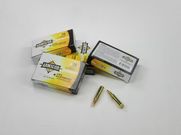
Armscor 223 Remington (MFG: FAC223-8N - UPC 4806015501633)
Although we normally shoot 5.56mm rounds, we do sometimes shoot .223 caliber for a change of pace. So, like our 5.56mm ammo, when we shoot .223 caliber rounds we use our Stag Model 3 that likes 62 grain rounds. The criteria that we use to evaluate .223 caliber ammunition are: 1) caliber, 2) bullet weight, 3) bullet material, 4) casing material, 5) quality, 6) expected number of failures, 7) dirtyness and 8) price. This .223 caliber ammunition (FAC223-8N) has a 62 grain pointed nose copper-FMJ bullet that has a muzzle velocity of 3,050 fps. It comes 20 to a box and normally can be found for approximately 45 cents per round. You can buy this ammo at targetsportsusa.com or your local gun stores.
If you're interested in the differences between .223 caliber and 5.56mm ammo here's a great 12:20 minute video from Ultimate Reloader's (https://ultimatereloader.com/) YouTube Channel ("gavintoobe") that you should watch; "223 -vs- 5.56: Facts and Myths".
Although we normally shoot 5.56mm rounds, we do sometimes shoot .223 caliber for a change of pace. So, like our 5.56mm ammo, when we shoot .223 caliber rounds we use our Stag Model 3 that likes 62 grain rounds. The criteria that we use to evaluate .223 caliber ammunition are: 1) caliber, 2) bullet weight, 3) bullet material, 4) casing material, 5) quality, 6) expected number of failures, 7) dirtyness and 8) price. This .223 caliber ammunition (FAC223-8N) has a 62 grain pointed nose copper-FMJ bullet that has a muzzle velocity of 3,050 fps. It comes 20 to a box and normally can be found for approximately 45 cents per round. You can buy this ammo at targetsportsusa.com or your local gun stores.
If you're interested in the differences between .223 caliber and 5.56mm ammo here's a great 12:20 minute video from Ultimate Reloader's (https://ultimatereloader.com/) YouTube Channel ("gavintoobe") that you should watch; "223 -vs- 5.56: Facts and Myths".
7.62 x 39mm Ammo
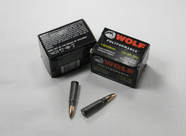
Wolf Polyformance 7.62x39mm Ammo 123 Grain FMJ Steel Case (MFG: 762BFMJ - UPC 645611762314) - if Hollow Points (MFG: 762BHP - UPC 645611762116)
Since we have an AK-47 derivative (Norinco MAK-90) we decided to keep the "low cost/rugged" experience as real as possible by using steel case ammunition in the firearm; even though there is a wide variation of opinions related to using steel vs. brass case ammo. The criteria that we use to evaluate 7.62 x 39mm ammunition are: 1) caliber, 2) bullet weight, 3) bullet material, 4) casing material, 5) quality, 6) expected number of failures, 7) dirtyness and 8) price. As with all other types of ammo, there are several brands of steel case ammo to choose from. Based on talking to other people that shoot steel case ammo, several detailed internet reviews and our testing at the range we found that Wolf and Bear ammo are probably the best choices. TulAmmo seems to have significantly more issues with both reliability and cleanliness.
The Wolf Polyformance 7.62 x 39mm ammunition (76239FMJ) has a 123 grain bimetal FMJ bullet (designed by compressing alternating sheets of copper and steel) that has a muzzle velocity of 2,396 fps. The round also has a berdan primer and a polymer coated steel casing to ensure smooth feeding and extraction. Unlike some other varieties of low priced steel cased ammo, this ammo is non-corrosive. If you want to see a detailed comparison of brass versus steel ammo - then you might want to look at the detailed 40,000 round test that Luckygunner performed. You can find the detailed test information here.
This ammo comes 20 to a box and normally can be found for approximately 22 cents per round. You can buy this ammo at targetsportsusa.com or your local gun stores.
Since we have an AK-47 derivative (Norinco MAK-90) we decided to keep the "low cost/rugged" experience as real as possible by using steel case ammunition in the firearm; even though there is a wide variation of opinions related to using steel vs. brass case ammo. The criteria that we use to evaluate 7.62 x 39mm ammunition are: 1) caliber, 2) bullet weight, 3) bullet material, 4) casing material, 5) quality, 6) expected number of failures, 7) dirtyness and 8) price. As with all other types of ammo, there are several brands of steel case ammo to choose from. Based on talking to other people that shoot steel case ammo, several detailed internet reviews and our testing at the range we found that Wolf and Bear ammo are probably the best choices. TulAmmo seems to have significantly more issues with both reliability and cleanliness.
The Wolf Polyformance 7.62 x 39mm ammunition (76239FMJ) has a 123 grain bimetal FMJ bullet (designed by compressing alternating sheets of copper and steel) that has a muzzle velocity of 2,396 fps. The round also has a berdan primer and a polymer coated steel casing to ensure smooth feeding and extraction. Unlike some other varieties of low priced steel cased ammo, this ammo is non-corrosive. If you want to see a detailed comparison of brass versus steel ammo - then you might want to look at the detailed 40,000 round test that Luckygunner performed. You can find the detailed test information here.
This ammo comes 20 to a box and normally can be found for approximately 22 cents per round. You can buy this ammo at targetsportsusa.com or your local gun stores.
.410 Bore Ammo
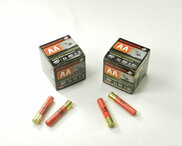
Winchester AA Super Sport 2 ½” #8 Birdshot Shells (MFG: AASC418 - UPC 020892016378)
We use our Henry lever action .410 bore shotgun mostly for shooting at clay and paper targets, so we wanted to keep the shot size consistent with the #8 shot that we use for 3-gun target shooting with our 12 gauge shotguns. An additional constraint was that the Henry is only chambered for 2½” shells. So we looked for a good quality shell that met those needs - not what you might buy for hunting. The criteria that we use to evaluate .410 bore ammunition are: 1) gauge, 2) shot size, 3) pellet material, 4) casing material, 5) quality, 6) expected number of failures, 7) dirtyness and 8) price. After trying out several brands of ammo, we ultimately chose to use Winchester AA Super Sport 2 ½” #8 Birdshot shells. This 2½” ammunition (AASC418) has lead pellets and a muzzle velocity of 1,300 fps. It comes 25 to a box and normally can be found for approximately 48 cents per shell. We like these shells since they have proven to be very reliable - which enhances the fun of using a lever action gun - since failures to eject (like we had with some other .410 ammo as detailed in our note on the Shotguns page) really break the flow. We also like the fact that you can also get this ammo in #8½ shot (AASC4185). You can buy this ammo online at Vizard’s Guns & Ammo or your local gun stores.
We use our Henry lever action .410 bore shotgun mostly for shooting at clay and paper targets, so we wanted to keep the shot size consistent with the #8 shot that we use for 3-gun target shooting with our 12 gauge shotguns. An additional constraint was that the Henry is only chambered for 2½” shells. So we looked for a good quality shell that met those needs - not what you might buy for hunting. The criteria that we use to evaluate .410 bore ammunition are: 1) gauge, 2) shot size, 3) pellet material, 4) casing material, 5) quality, 6) expected number of failures, 7) dirtyness and 8) price. After trying out several brands of ammo, we ultimately chose to use Winchester AA Super Sport 2 ½” #8 Birdshot shells. This 2½” ammunition (AASC418) has lead pellets and a muzzle velocity of 1,300 fps. It comes 25 to a box and normally can be found for approximately 48 cents per shell. We like these shells since they have proven to be very reliable - which enhances the fun of using a lever action gun - since failures to eject (like we had with some other .410 ammo as detailed in our note on the Shotguns page) really break the flow. We also like the fact that you can also get this ammo in #8½ shot (AASC4185). You can buy this ammo online at Vizard’s Guns & Ammo or your local gun stores.
12 Gauge Ammo
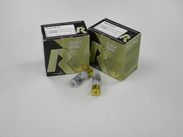
Rio Royal Buck 2 ¾” #00 Buckshot Shells (MFG: RB12925 - UPC 8435101602198)
For our shotguns we find that 2 ¾” shells fit what we use it for; target shooting at the indoor/outdoor ranges and home defense. So we looked for a good quality shell that met those needs and not what you might buy for hunting. The criteria that we use to evaluate 12 gauge ammunition are: 1) gauge, 2) number of pellets, 3) pellet material, 4) casing material, 5) quality, 6) expected number of failures, 7) dirtyness and 8) price. We ultimately chose to use Rio Royal Buck 2 3/4" shells. This 2 3/4" 12 gauge ammunition (RB12925) has 9 lead pellets of #00 buckshot that have a muzzle velocity of 1,345 fps. It comes 25 to a box and normally can be found for approximately 44 cents per shell. Although they have been in business since 1896 many people don’t know much about Rio Ammunition. They are a large ordnance company based in Spain that opened a large plant in Marshall Texas in 2015. We really like their products and find their prices to be affordable enough to allow you to shoot lots of shells. You can buy this ammo at targetsportsusa.com or your local gun stores.
For our shotguns we find that 2 ¾” shells fit what we use it for; target shooting at the indoor/outdoor ranges and home defense. So we looked for a good quality shell that met those needs and not what you might buy for hunting. The criteria that we use to evaluate 12 gauge ammunition are: 1) gauge, 2) number of pellets, 3) pellet material, 4) casing material, 5) quality, 6) expected number of failures, 7) dirtyness and 8) price. We ultimately chose to use Rio Royal Buck 2 3/4" shells. This 2 3/4" 12 gauge ammunition (RB12925) has 9 lead pellets of #00 buckshot that have a muzzle velocity of 1,345 fps. It comes 25 to a box and normally can be found for approximately 44 cents per shell. Although they have been in business since 1896 many people don’t know much about Rio Ammunition. They are a large ordnance company based in Spain that opened a large plant in Marshall Texas in 2015. We really like their products and find their prices to be affordable enough to allow you to shoot lots of shells. You can buy this ammo at targetsportsusa.com or your local gun stores.
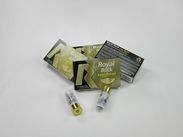
Rio Royal Buck Low Recoil 2 ¾” #00 Buckshot Shells (MFG: RBLR129 - UPC 8435101602204)
Since one of our uses for our shotguns is home defense, we looked for a round that had lower recoil. The criteria that we use to evaluate 12 gauge ammunition are: 1) gauge, 2) number of pellets, 3) pellet material, 4) casing material, 5) quality, 6) expected number of failures, 7) dirtiness, 8) recoil and 9) price. Here again we were lucky since Rio makes a Low recoil version of their Royal Buck shotgun shell. This 2 3/4" 12 gauge ammunition (RBLR129) has 9 lead pellets of #00 buckshot that have a muzzle velocity of 1,200 fps. It comes 5 to a box and normally can be found for approximately 44 cents per shell. You can buy this ammo at targetsportsusa.com or your local gun stores.
Since one of our uses for our shotguns is home defense, we looked for a round that had lower recoil. The criteria that we use to evaluate 12 gauge ammunition are: 1) gauge, 2) number of pellets, 3) pellet material, 4) casing material, 5) quality, 6) expected number of failures, 7) dirtiness, 8) recoil and 9) price. Here again we were lucky since Rio makes a Low recoil version of their Royal Buck shotgun shell. This 2 3/4" 12 gauge ammunition (RBLR129) has 9 lead pellets of #00 buckshot that have a muzzle velocity of 1,200 fps. It comes 5 to a box and normally can be found for approximately 44 cents per shell. You can buy this ammo at targetsportsusa.com or your local gun stores.
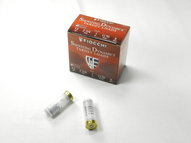
Fiocchi Shooting Dynamics Target Loads 2 ¾” #8 Shot Shells (MFG: 12SD1L8 - UPC 762344705538)
Normally we use 2 ¾” #00 Buckshot shells in our shotguns since they are “tactical” in nature (as opposed to being used for skeet shooting or hunting). However, because we also do some 3-gun shooting, where #00 Buckshot is overkill for shooting at clay and paper targets, we decided that we needed to find a good #8 shot shell for the 3-gun range. The criteria that we use to evaluate 12 gauge ammunition are: 1) gauge, 2) number of pellets/shot size, 3) pellet material, 4) casing material, 5) quality, 6) expected number of failures, 7) dirtyness and 8) price.
After testing 4 different #8 shell types we decided to use the “Fiocchi Shooting Dynamics Target Loads” 2 ¾” #8 shot shells for our 3-gun activities. This 2 ¾" 12 gauge ammunition (Manufacturer #12SD1L8, UPC #762344705538) has #8 size lead pellets with a muzzle velocity of 1,170 fps. The shells come 25 to a box and provide a good balance between economy and performance since they can normally be found for approximately 25 cents per shell.
We really like these shells since they are good quality, reliable shotgun shells. The shells have a one-piece shot cup, clean-burning powder, reliable Fiocchi primers, cushioned wads and first-run chilled shot high-antimony (5%) lead pellets with nearly perfect round shape. The shells give a nice tight pattern due to the 1,170 fps velocity and lead pellet shape consistency. We never had a FTF (failure to feed) or FTE (failure to eject) during our testing. Perhaps these shells are so good because Fiocchi is the world leader in shot shell manufacturing (making more than 500 million cases each year) and they helped pioneer the lower recoil 1 oz load.
If you are interested in the details of the other 3 shells that we compared the Fiocchi Shooting Dynamics Target Loads against you can read that blog post here - “Trying Out New #8 Shot Shells”.
You can buy this ammo at Cabela’s or your local gun stores.
Normally we use 2 ¾” #00 Buckshot shells in our shotguns since they are “tactical” in nature (as opposed to being used for skeet shooting or hunting). However, because we also do some 3-gun shooting, where #00 Buckshot is overkill for shooting at clay and paper targets, we decided that we needed to find a good #8 shot shell for the 3-gun range. The criteria that we use to evaluate 12 gauge ammunition are: 1) gauge, 2) number of pellets/shot size, 3) pellet material, 4) casing material, 5) quality, 6) expected number of failures, 7) dirtyness and 8) price.
After testing 4 different #8 shell types we decided to use the “Fiocchi Shooting Dynamics Target Loads” 2 ¾” #8 shot shells for our 3-gun activities. This 2 ¾" 12 gauge ammunition (Manufacturer #12SD1L8, UPC #762344705538) has #8 size lead pellets with a muzzle velocity of 1,170 fps. The shells come 25 to a box and provide a good balance between economy and performance since they can normally be found for approximately 25 cents per shell.
We really like these shells since they are good quality, reliable shotgun shells. The shells have a one-piece shot cup, clean-burning powder, reliable Fiocchi primers, cushioned wads and first-run chilled shot high-antimony (5%) lead pellets with nearly perfect round shape. The shells give a nice tight pattern due to the 1,170 fps velocity and lead pellet shape consistency. We never had a FTF (failure to feed) or FTE (failure to eject) during our testing. Perhaps these shells are so good because Fiocchi is the world leader in shot shell manufacturing (making more than 500 million cases each year) and they helped pioneer the lower recoil 1 oz load.
If you are interested in the details of the other 3 shells that we compared the Fiocchi Shooting Dynamics Target Loads against you can read that blog post here - “Trying Out New #8 Shot Shells”.
You can buy this ammo at Cabela’s or your local gun stores.
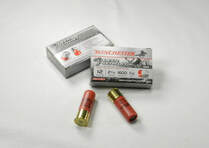
Winchester High Velocity 2 ¾” Lead Slugs (MFG: X12DS - UPC 020892024441)
Although we usually shoot #00 buckshot in our 12 gauge shotguns (with some #8 birdshot for 3-gun activities), for some situations you want a slug instead of shot - especially if you really want knockdown power. The criteria that we use to evaluate 12 gauge slugs are: 1) slug weight, 2) ability to use in smooth bore, rifled choke tube or fully rifled barrels, 3) casing material, 4) quality, 5) expected number of failures, 6) dirtyness and 7) price. Because almost all of the slugs out there are for hunting we looked at deer shells – and made sure that they would work in more than just smooth bore firearms, since we have a variety of 12 gauge shotguns. Ultimately we chose to use Winchester High Velocity 2 ¾” Lead Slug (X12DS) shells because they are specifically made for stopping power for whitetail, mule and blacktail deer, and will easily work in different firearms. The 2 ¾” shells have a muzzle velocity of 1,600 fps with a slug weight of 1 1/8 ounces. The shells also have an integrated plastic stabilizing wad that travels down range with the slug to give you better accuracy. On impact the slug and wad separate to deliver maximum energy on target. The shells come 5 to a box and normally can be found for approximately 90 cents per shell. You can buy this ammo online at Vizard’s Guns & Ammo or your local gun stores.
Although we usually shoot #00 buckshot in our 12 gauge shotguns (with some #8 birdshot for 3-gun activities), for some situations you want a slug instead of shot - especially if you really want knockdown power. The criteria that we use to evaluate 12 gauge slugs are: 1) slug weight, 2) ability to use in smooth bore, rifled choke tube or fully rifled barrels, 3) casing material, 4) quality, 5) expected number of failures, 6) dirtyness and 7) price. Because almost all of the slugs out there are for hunting we looked at deer shells – and made sure that they would work in more than just smooth bore firearms, since we have a variety of 12 gauge shotguns. Ultimately we chose to use Winchester High Velocity 2 ¾” Lead Slug (X12DS) shells because they are specifically made for stopping power for whitetail, mule and blacktail deer, and will easily work in different firearms. The 2 ¾” shells have a muzzle velocity of 1,600 fps with a slug weight of 1 1/8 ounces. The shells also have an integrated plastic stabilizing wad that travels down range with the slug to give you better accuracy. On impact the slug and wad separate to deliver maximum energy on target. The shells come 5 to a box and normally can be found for approximately 90 cents per shell. You can buy this ammo online at Vizard’s Guns & Ammo or your local gun stores.